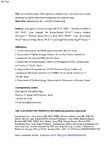Mostrar o rexistro simple do ítem
Comparative study of the glistening between four intraocular lens models assessed by OCT and deep learning
| dc.contributor.author | Fernández-Vigo, José Ignacio | |
| dc.contributor.author | Macarro-Merino, Ana | |
| dc.contributor.author | Moura, Joaquim de | |
| dc.contributor.author | Álvarez-Rodríguez, Lorena | |
| dc.contributor.author | Burgos-Blasco, Barbara | |
| dc.contributor.author | Novo Buján, Jorge | |
| dc.contributor.author | Ortega Hortas, Marcos | |
| dc.contributor.author | Fernández-Vigo, José A. | |
| dc.date.accessioned | 2024-05-16T11:21:51Z | |
| dc.date.issued | 2024-01 | |
| dc.identifier.citation | Fernández-Vigo, José Ignacio; Macarro-Merino, Ana; De Moura-Ramos, Jose Joaquim; Alvarez-Rodriguez, Lorena; Burgos-Blasco, Barbara; Novo-Bujan, Jorge; Ortega-Hortas, Marcos; Fernández-Vigo, José Ángel. Comparative study of the glistening between four intraocular lens models assessed by OCT and deep learning. Journal of Cataract & Refractive Surgery 50(1):p 37-42, January 2024. | DOI: 10.1097/j.jcrs.0000000000001316 | es_ES |
| dc.identifier.issn | 0886-3350 | |
| dc.identifier.issn | 1873-4502 | |
| dc.identifier.uri | http://hdl.handle.net/2183/36499 | |
| dc.description.abstract | Purpose: To evaluate the glistening in 4 different models of intraocular lenses (IOLs) using optical coherence tomography (OCT) and deep learning (DL). Setting: Centro Internacional de Oftalmología Avanzada (Madrid, Spain). Design: Cross-sectional study. Methods: 325 eyes were assessed for the presence and severity of glistening in 4 IOL models: ReSTOR+3 SN6AD1 (n = 41), SN60WF (n = 110), PanOptix TFNT (n = 128) and Vivity DFT015 (n = 46). The presence of glistening was analyzed using OCT, identifying the presence of hyperreflective foci (HRF) in the central area of the IOL. A manual and an original DL-based quantification algorithm designed for this purpose was applied. Results: Glistening was detected in 22 (53.7%) ReSTOR SN6AD1, 44 (40%) SN60WF, 49 (38.3%) PanOptix TFNT, and 4 (8.7%) Vivity DFT015 IOLs, when any grade was considered. In the comparison of the different types of IOLs, global glistening measured as total HRF was 17.3 ± 25.9 for the ReSTOR+3; 9.3 ± 15.7 for the SN60WF; 6.9 ± 10.5 for the PanOptix; and 1.2 ± 2.6 for the Vivity (P < .05). There was excellent agreement between manual and DL-based quantification (≥0.829). Conclusions: It is possible to quantify, classify and compare the glistening severity in different IOL models using OCT images in a simple and objective manner with a DL algorithm. In the comparative study, the Vivity presented the lowest severity of glistening. | es_ES |
| dc.language.iso | eng | es_ES |
| dc.publisher | Wolters Kluwer on behalf of ASCRS and ESCRS | es_ES |
| dc.relation.uri | https://doi.org/10.1097/j.jcrs.0000000000001316 | es_ES |
| dc.rights | Copyright © 2024, Copyright © 2023 Published by Wolters Kluwer on behalf of ASCRS and ESCRS | es_ES |
| dc.subject | Glistening | es_ES |
| dc.subject | Intraocular lens | es_ES |
| dc.subject | Opacification | es_ES |
| dc.subject | Optical coherence tomography | es_ES |
| dc.subject | Deep learning | es_ES |
| dc.subject | Acrysof | es_ES |
| dc.title | Comparative study of the glistening between four intraocular lens models assessed by OCT and deep learning | es_ES |
| dc.type | journal article | es_ES |
| dc.rights.accessRights | embargoed access | es_ES |
| dc.date.embargoEndDate | 2025-01-01 | es_ES |
| dc.date.embargoLift | 2025-01-01 | |
| UDC.journalTitle | Journal of Cataract & Refractive Surgery | es_ES |
| UDC.volume | 50 | es_ES |
| UDC.issue | 1 | es_ES |
| UDC.startPage | 37 | es_ES |
| UDC.endPage | 42 | es_ES |
| UDC.coleccion | Investigación | es_ES |
| UDC.departamento | Ciencias da Computación e Tecnoloxías da Información | es_ES |
| UDC.grupoInv | Grupo de Visión Artificial e Recoñecemento de Patróns (VARPA) | es_ES |
Ficheiros no ítem
Este ítem aparece na(s) seguinte(s) colección(s)
-
Investigación (FIC) [1683]






